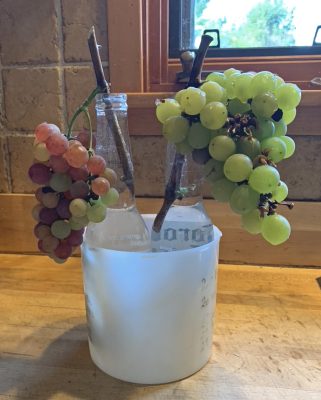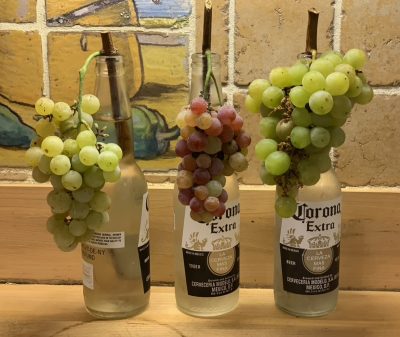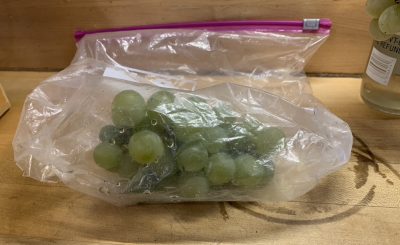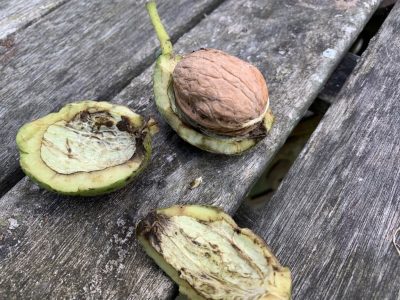GRAPE and NUTS
Long-term Grapes
About a month ago, I picked a bunch of grapes as I was walking around the farmden with a friend, and handed it to him to taste. “Wow,” he exclaimed, eyes lighting up, “that really has taste.” That was the variety Brianna, one of many I grow that are otherwise not well-known, surely not to anyone who doesn’t grow grapes. My friend and I went on to agree that store-bought grapes are, “at best, nothing more than little sacks of sugary water.”
All that’s history now. Over the past month, most of the remaining grapes have either been harvested, eaten by birds or insects, or rotted, although a few very tasty berries can be salvaged here and there from some ugly bunches still hanging.
But are those grape-ful days gone yet? Years ago I read about how, over a century ago in France, fresh grapes were sometimes preserved by cutting off bunches along with a length of stem, the bottom of which was slid into a narrow-mouthed, water filled bottle. These bottles were then placed in a rack on shelves in cold storage which, where outdoor temperatures rarely dipped below freezing, was nothing more than a slightly insulated, outdoor room.

Grapes, fresh picked
A month ago, I emulated those French grape growers of yore, in this case using Corona beer bottles, three of them, three grape varieties, and my refrigerator — very decorative looking.

Grapes, after 1 month storage
For a modern version, another bunch of grapes went into the refrigerator in a sealed freezer bag.  If any of this worked out, the plan was to use either the old-fashioned or modern method with a whole bunch of bunches in my walk-in, insulated and with some cooling or heating, as needed, fruit and vegetable storage room.
If any of this worked out, the plan was to use either the old-fashioned or modern method with a whole bunch of bunches in my walk-in, insulated and with some cooling or heating, as needed, fruit and vegetable storage room.
Back in the olden days, storing fresh grapes was not so rare even on this side of the Atlantic. Professor Frank Waugh, in his 1901 book Fruit Harvesting Storing, Marketing, wrote “An acquaintance of mine from the grape-growing district wrote me the other day (March 12th), ‘A neighbor of mine has one hundred tons of Catawbas still in storage.’” Probably not as single bunches on stems in bottles of water!
Anyway . . . drum roll . . . yesterday it was time to taste my stored grapes. One variety, Glenora, didn’t hold up well. The other two, Lorelei and Brianna, were very good. “Bottled” bunches were very slightly shriveled, but tasted quite good. Perhaps they would do better in the more humid atmosphere of the walk-in cold storage room. The bagged bunch, Brianna, was plump and also tasty.
Admittedly, none of the stored bunches had the crisp texture or fresh flavor of the few berries hanging on ugly bunches still outside. But all were better than any fresh grapes I can buy.
Walnuts at the Car Wash
Storage of nuts, also abundant this time of year, is more straightforward. You pick them up from the ground, let them cure in a cool place away from squirrels, then crack and eat them at your leisure.
With black walnuts, the green husks must be removed and the nuts within cleaned up. Leaving the husks to soften and darken a little makes them very easy, although tedious, to remove. Of the many suggested methods, twisting them off with two rubber-gloved hands seems most effective.
As far as cleaning up the hulled nuts, an old fashioned washing machined, earmarked only for this purpose, would work well. I don’t have one, so came up with an effective alternative.
After spreading out all the husked nuts into eight black plastic vegetable harvest boxes, I loaded them in the back of my truck. And then it was off to the car wash. A couple of rounds with the high pressure water spray did the trick. It was a messy job that I was prepared for with rain coat and pants, boots, hat, and face shield. The truck needed a washing anyway.
Spreading out the trays on the deck exposed for a few days to bright sunlight had them all clean and dry. Squirrels would normally be a threat but the deck is also where Sammy and Daisy, my dogs, spend much of their days.

Previous generation watchdogs, Leila and Scooter, on deck
Finally, the nuts were put into five half-bushel baskets for cracking beginning towards the end of December, which is about when last year’s nuts will be finished up.
Harvest Tragedy
I was never that hopeful for English walnuts here (also called Persian or White walnuts). This species is not all that cold-hardy, their blossoms are susceptible to late frosts, which are common here on the farmden, their leaves are susceptible to anthracnose disease, and the only place I had for them was near the road, along the squirrel highway (telephone, cable, and electric wires).
Still, I couldn’t resist, back in 2006, an offer of seeds for some “hardy” varieties. I planted two groups of three trees each, planning to cull out any weaker ones in each group.
All the trees grew well, and I eagerly awaited blossoms which, finally, this year, appeared in abundance. That abundance was followed by an abundance of nuts, and everything looked healthy. Then disaster, in the form of squirrels, struck. Every single nut was stripped from the trees.
Well, not every single nut. One nut was left, which I harvested, easily popped out of its husk, and let sit — cure — on the kitchen table for a couple of weeks. Then, with great fanfare, it was cracked open and eaten.

This year’s English walnut harvest
As luck would have it, I also had a bag of store-bought English walnuts with which to compare in taste. No contest. Store-bought tasted rancid in comparison.
Next year, in enough time before the nuts start to ripen, I plan to spray all the trees with a hot pepper spray.
Any other suggestions would be most welcome.


Growing up we had plenty of black walnut trees on our property and gathered the nuts every fall. My father put them in a ditch and ran a car over them to remove the husks. Then we collected them from the ditch – wearing gloves! Later in the winter, we cracked them with a hammer and picked the meat out. I can remember coming home from school and sitting at a table with a pile of cracked walnuts waiting for me. I never liked the flavor of black walnuts, so I never snitched any. I did enjoy the camaraderie of sitting with my sister and/or mother picking the meat from the shells. As for the squirrels, I have a trap called the squirrelinator that lets me relocate the little fellas. Two years ago I trapped 11 that were eating from my bird feeders. Last year I had none in the yard. This year I’ve trapped 7 since Sunday when I put the feeders out. You might think you’ll never get to the end of them, but you will. I let them go about 3 miles from my home in the parking lot of a trail.
This year squirrels stripped the fruit on my Cornus mas ‘Elegant’ in the early summer, while the fruit was young and green. Last year they allowed the fruit to ripen and we shared a good amount. I was surprised the squirrels ate it so young, because it is so astringent when even a bit under-ripe.
Squireels often eat underripe fruit. Typically, they’ll strip apricot or peach trees of their fruit in mid June here, when they’re dime size and green. They may be going for the soft seeds.
Squirrels often eat underripe fruit. Typically, they’ll strip apricot or peach trees of their fruit in mid June here, when they’re dime size and green. They may be going for the soft seeds.
Fascinating and useful, thanks Once a scientist, always a scientist. One question. How will you spray the trees with a hot pepper spray. We’ve got a ground squirrel problem here and having an effective spray would be a great help. Thanks again
I’m going to either make or buy a hot pepper spray and then use my backpack sprayer. While spraying, I’m going to suit up in head to toe rain gear along with goggles and face mask, maybe even a full face mask that I have. This all might freak my neighbors out and require explanation.
Same thing happened to my first full crop of Hazelnuts. We worked all summer keeping the Japaneses beetles off daily and the nuts looked beautiful. The day we decided to pick was the same day the squirrels chose. Not one left. I’ll try pepper spray next year.
It used to sometimes happen to my hazels until I let the surrounding field grow high almost up to the plants and id a lot of trapping.
My father-in-law used to wrap aluminum flashing around the trunks of his two English walnut trees and then watch and laugh as the squirrels would run up the metal and slide down. His trees were isolated in the yard so that the squirrels could not jump over from other trees and he kept the branches trimmed to at least six feet off the ground. We are in Michigan and he had some great (many bushels of nuts) years and some low years. I totally agree that Michigan-grown nuts far out-flavor store bought nuts!
Good idea, except for my trees being right under the power lines and branching too low.
My thought regarding the squirrels is to feed them black oil sunflower seed before your tree nuts become a target. I spread a seed mix on the ground underneath my bird feeder and the squirrels really go for the sunflower seed.
One thing I like about red grocery store grapes is the nice crispy easy to eat skin. Are there any varieties like that worth growing in western NY?
I think your squirrel idea would just attract more squirrels.
As far as grapes, consider Vanessa and Somerset Seedless. I am in the colder part of zone 5 and Vanessa sometimes gets some cold damage, but otherwise would be just what you want. Somerset Seedless is very hardy.